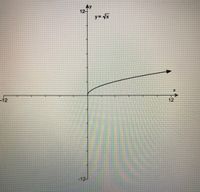
Calculus: Early Transcendentals
8th Edition
ISBN: 9781285741550
Author: James Stewart
Publisher: Cengage Learning
expand_more
expand_more
format_list_bulleted
Question
What is the graph? Domain & Range? please help??
![**Graph the Function Using Transformations**
Graph the following function using the techniques of shifting, compressing, stretching, and/or reflecting. Start with the graph of the basic function shown to the right. Find the domain and range of the function.
\[ h(x) = \sqrt{x} + 2 \]](https://content.bartleby.com/qna-images/question/adc9b7a0-ee6c-4009-a665-cc3510a07858/e53acf9f-bd49-4dc3-9030-9070d4909643/wkv207o_thumbnail.jpeg)
Transcribed Image Text:**Graph the Function Using Transformations**
Graph the following function using the techniques of shifting, compressing, stretching, and/or reflecting. Start with the graph of the basic function shown to the right. Find the domain and range of the function.
\[ h(x) = \sqrt{x} + 2 \]

Transcribed Image Text:The image displays a graph of the function \( y = \sqrt{x} \). Below is a detailed explanation:
### Description of the Graph:
- **Axes**: The graph is plotted on a Cartesian plane with the horizontal axis labeled as \( x \) and the vertical axis labeled as \( y \). Both axes range from \(-12\) to \(12\).
- **Curve**: The function \( y = \sqrt{x} \) is depicted as a curve starting at the origin (0,0) and extending towards the right. The curve is only defined for non-negative values of \( x \) (i.e., \( x \geq 0 \)) since the square root of a negative number is not a real number.
- **Direction**: The curve rises slowly as it moves to the right, indicating that as \( x \) increases, \( y \) (i.e., \( \sqrt{x} \)) also increases, but at a decreasing rate.
- **Key Points**: No specific key points are marked on the graph, but it is clear that the curve passes through the origin.
### Characteristics of the Function:
- **Domain**: \( x \geq 0 \)
- **Range**: \( y \geq 0 \)
- **Intercept**: The graph intersects the origin (0,0).
This graphical representation is useful for visualizing how the square root function behaves, illustrating its increasing nature and showing its restriction to non-negative values of \( x \).
Expert Solution
This question has been solved!
Explore an expertly crafted, step-by-step solution for a thorough understanding of key concepts.
This is a popular solution
Trending nowThis is a popular solution!
Step by stepSolved in 2 steps with 1 images

Knowledge Booster
Learn more about
Need a deep-dive on the concept behind this application? Look no further. Learn more about this topic, calculus and related others by exploring similar questions and additional content below.Similar questions
- Please see attachedarrow_forwardDescribe how to graph a line using the slope and y-intercept. Provide an original example with your description.arrow_forwardExplain whether to use x values or y values when describing the domain of a graph. Include a square root graph , it’s domain in interval notation, and explain why.arrow_forward
- Name: Date Per Homework: The county fair charges a $10 parking fee. and admission tickets cost $7 per person. Create an equation, table ara graph that describes the relationship between the total cost to attena the fair (©) if Mr. Nguyen purchases'tickets for a certain number of people (p). Equation: Table: Graph: ain.arrow_forwardbottom part about inflection points and graphs not answeredarrow_forwardWhen the equation is into a fraction how to get rid of the fraction on a grapharrow_forward
arrow_back_ios
arrow_forward_ios
Recommended textbooks for you
 Calculus: Early TranscendentalsCalculusISBN:9781285741550Author:James StewartPublisher:Cengage Learning
Calculus: Early TranscendentalsCalculusISBN:9781285741550Author:James StewartPublisher:Cengage Learning Thomas' Calculus (14th Edition)CalculusISBN:9780134438986Author:Joel R. Hass, Christopher E. Heil, Maurice D. WeirPublisher:PEARSON
Thomas' Calculus (14th Edition)CalculusISBN:9780134438986Author:Joel R. Hass, Christopher E. Heil, Maurice D. WeirPublisher:PEARSON Calculus: Early Transcendentals (3rd Edition)CalculusISBN:9780134763644Author:William L. Briggs, Lyle Cochran, Bernard Gillett, Eric SchulzPublisher:PEARSON
Calculus: Early Transcendentals (3rd Edition)CalculusISBN:9780134763644Author:William L. Briggs, Lyle Cochran, Bernard Gillett, Eric SchulzPublisher:PEARSON Calculus: Early TranscendentalsCalculusISBN:9781319050740Author:Jon Rogawski, Colin Adams, Robert FranzosaPublisher:W. H. Freeman
Calculus: Early TranscendentalsCalculusISBN:9781319050740Author:Jon Rogawski, Colin Adams, Robert FranzosaPublisher:W. H. Freeman
 Calculus: Early Transcendental FunctionsCalculusISBN:9781337552516Author:Ron Larson, Bruce H. EdwardsPublisher:Cengage Learning
Calculus: Early Transcendental FunctionsCalculusISBN:9781337552516Author:Ron Larson, Bruce H. EdwardsPublisher:Cengage Learning

Calculus: Early Transcendentals
Calculus
ISBN:9781285741550
Author:James Stewart
Publisher:Cengage Learning

Thomas' Calculus (14th Edition)
Calculus
ISBN:9780134438986
Author:Joel R. Hass, Christopher E. Heil, Maurice D. Weir
Publisher:PEARSON

Calculus: Early Transcendentals (3rd Edition)
Calculus
ISBN:9780134763644
Author:William L. Briggs, Lyle Cochran, Bernard Gillett, Eric Schulz
Publisher:PEARSON

Calculus: Early Transcendentals
Calculus
ISBN:9781319050740
Author:Jon Rogawski, Colin Adams, Robert Franzosa
Publisher:W. H. Freeman


Calculus: Early Transcendental Functions
Calculus
ISBN:9781337552516
Author:Ron Larson, Bruce H. Edwards
Publisher:Cengage Learning